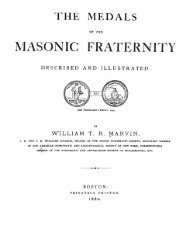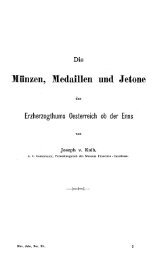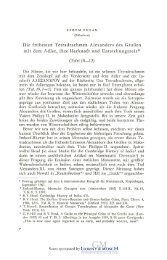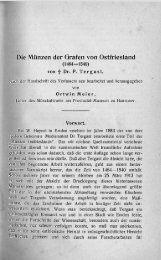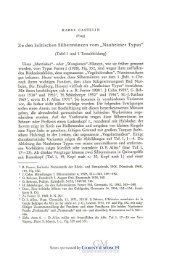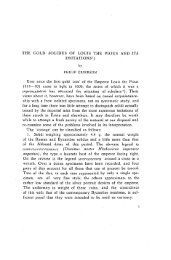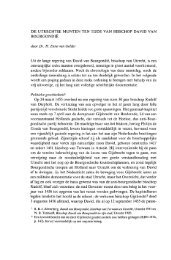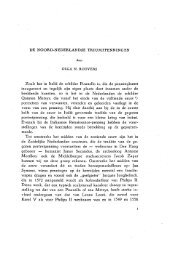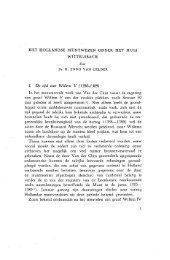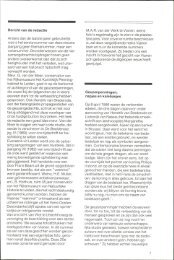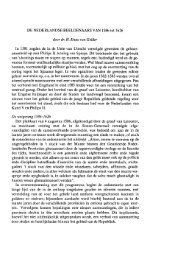Create successful ePaper yourself
Turn your PDF publications into a flip-book with our unique Google optimized e-Paper software.
NEW CONSIDERATIONS ON MAMLÜK HERALDRY<br />
PAUL BALOG<br />
When my book <strong>on</strong> the coinage of the Mamlük sultans of Egypt and<br />
Syria appeared,1 I was under the impressi<strong>on</strong> that Mamlük <strong>heraldry</strong><br />
was, to a large extent, governed by rigid rules in the same way äs<br />
European <strong>heraldry</strong>, which must have inspired it. I naturally profited<br />
by the extensive Informati<strong>on</strong> in L. A. Mayer's Saracenic Heraldry.2 The<br />
oldest known Muslim blaz<strong>on</strong> is probably the fleur-de-lis carved in st<strong>on</strong>e<br />
in the Damascus märistän built by Mahmud b. Zangi in A.D. 1154,<br />
when the Muslims had already been in c<strong>on</strong>tact with the Crusaders for<br />
50-odd years; it is a faithful replica of a European heraldic fleur-de-lis.3<br />
The armorial roll of Mamlük amlrs in Mayer's work is based <strong>on</strong> blaz<strong>on</strong>s<br />
from buildings, such äs mosques, madrasas, mausoleums, cenotaphs,<br />
castles and palaces; and from glass objects such äs mosque lamps, flasks,<br />
bottles, and vases; and from such metal objects äs chandeliers, eandlesticks,<br />
basins, plates, dishes, pen boxes, chamfr<strong>on</strong>s (headpieces of horse<br />
armor), and doorfittings. Blaz<strong>on</strong>s can be found carved in or painted<br />
<strong>on</strong> woodwork, woven into textiles, and <strong>on</strong> thousands of pottery fragments.<br />
The latter are seldom of any use, however, äs they are rarely<br />
accompanied by identifying legends. Mayer also included a few copper<br />
coins with blaz<strong>on</strong>s of six Mamlük sultans in his armorial roll.<br />
As I had a large quantity of coins at my disposal whilc wriiing my<br />
book <strong>on</strong> Mamlük coinage it seemed useful to c<strong>on</strong>tiime the study of Lhe<br />
<strong>heraldry</strong> of their sultans, which was barely approached by Mayer,<br />
and include the result in the book. Since then, my prol<strong>on</strong>ged work with<br />
1 P. Balog, Coinage of the Mamlük Sultans of Egijpt and Syrier, NS 12 (<str<strong>on</strong>g>New</str<strong>on</strong>g> York,<br />
1964) (hercaftcr cited äs MSES); "The Coitiage of the Mamlük Sultans: Adlliti<strong>on</strong>s<br />
and Corrccti<strong>on</strong>s," ANSMN 16 (1970), pp. 113-72 (hcrcafter cited äs MSESAtM).<br />
2 L. A. Mayer, Saracenic Heraldry (Oxford, 1933).<br />
3 Mayer, pp. 22, 152, pl. 19,1.
184 PAUL BALOG<br />
Mamlük coinage has resulted in changes in my ideas <strong>on</strong> the nature and<br />
aspects of the Mamlük nobility, their rules and usages, and their attitudc<br />
toward the blaz<strong>on</strong>. I have also realized that heraldic figures <strong>on</strong> the<br />
coins had to be c<strong>on</strong>sidered more cautiously, with a different point of<br />
view from that used in judging a European coat of arms. However,<br />
I am still firmly c<strong>on</strong>vinced that the figures are all intended to represent<br />
the sultan <strong>on</strong> whose coins they are engraved.<br />
The pers<strong>on</strong>al objects <strong>on</strong> whieh the owner's blaz<strong>on</strong> was engraved or<br />
depicted were always under the eyes of the proprietor. We can therefore<br />
assume that the coat of arms was executed exactly and faithfully according<br />
to the original model. But pers<strong>on</strong>al objects, and even tombs,<br />
are Seen by few people, while a mosque or other public building has an<br />
official character. Therefore, the blaz<strong>on</strong>s <strong>on</strong> public buildings should<br />
more reliably be of correct design.<br />
Official written documents <strong>on</strong> which the blaz<strong>on</strong> of the appointee may<br />
have been depicted, such äs firmans, and appointments to court office,<br />
governorship or an even higher office, no l<strong>on</strong>ger exist. It is <strong>on</strong> coins<br />
that we have the most official and widely-advertised documents o<br />
sultanic authority which reached the eyes of the entire populati<strong>on</strong>. I<br />
believe that, in c<strong>on</strong>sequence, the blaz<strong>on</strong>s <strong>on</strong> Mamlük coins can be<br />
relied <strong>on</strong> äs official emblems of the sovereign who had them struck.<br />
Copper coins are not manufactured with the greatest care, but even<br />
when their executi<strong>on</strong> is inartistic or outright careless, I am c<strong>on</strong>vinced<br />
that they bear <strong>on</strong>e or another of the devices adopted by the sultan.<br />
Puzzling details remain, like the seeming irregulär multiplicity of tluemblems<br />
for a sultan but Muslim <strong>heraldry</strong> is not based <strong>on</strong> rules äs rigid<br />
äs those of its European counterpart, a point which will be c<strong>on</strong>sidered<br />
below. l<br />
In a paper published in 1970, J. W. Allan criticized my views <strong>on</strong><br />
Mamlük <strong>heraldry</strong>.4 Stimulated by his objecti<strong>on</strong>s and c<strong>on</strong>clusi<strong>on</strong>s, I took<br />
up an extended study not <strong>on</strong>ly of the coinage, but also of the literature<br />
touching up<strong>on</strong> the subject of Islamic blaz<strong>on</strong>s. Mediaeval Arabic literature<br />
c<strong>on</strong>cerning <strong>heraldry</strong> is, however, scanty and descripti<strong>on</strong>s of blaz<strong>on</strong>s<br />
are either n<strong>on</strong>-existent or unsatisfactory. Only Abü'1-Fidä presents use-<br />
4 J. W. Allan, "Mamlük Sultanic Heraldry and the Numismatic Evidence: A<br />
Reinterpretati<strong>on</strong>," JRAS 2 (1970), pp. 19-112. '
MAMLÜK HERALDRY 185<br />
ful notes <strong>on</strong> court Offices and the heraldic signs which represent them<br />
<strong>on</strong> the blaz<strong>on</strong>. Mayer remarks briefly <strong>on</strong> what he believes to be the<br />
oldest Saracen blaz<strong>on</strong>s, but his sources are not always reliable. The<br />
fleur-de-lis already menti<strong>on</strong>ed is the oldest existing Islamic blaz<strong>on</strong>.<br />
Other emblems, in the main mosque at Irlims and attributed by Mayer<br />
to the same sultan, are much later, while the <strong>on</strong>ly authentic Ayyübid<br />
blaz<strong>on</strong> is <strong>on</strong> the IrTarrän gate of Urfa, built by al-Muzaffar Ghäzi b.<br />
al-'Ädil L According to Mayer, the rosette is the oldest Ayyübid<br />
heraldic device, and is found in the north tower of Qal'ät al-Mudiq,<br />
but it seems to me to be <strong>on</strong>ly an ornament, not a blaz<strong>on</strong>. Although<br />
the coat of arms of Abü'l-Fidä and his grands<strong>on</strong>, 'All b. clmäd al-<br />
Din, are true Ayyübid family shields, they should be relegated to the<br />
Mamlük period. As they are absolutely different from the <strong>on</strong>ly authentic<br />
Ayyübid blaz<strong>on</strong> from the~time when the Ayyübids ruled, the latter bel<strong>on</strong>ged<br />
to the prince of Mayäfärigm, al-Muzaffar Ghäzi and c<strong>on</strong>sisted of<br />
a walking li<strong>on</strong> facing a man. When comparing the various blaz<strong>on</strong>s of the<br />
Ayyübids with each other, the questi<strong>on</strong> arises to what extent they can be<br />
c<strong>on</strong>sidered true family blaz<strong>on</strong>s. Finally, the copper coin with heraldic<br />
fleur-de-lis which Lane Poole attributed to al-Zähir Ghäzi of Aleppo and I<br />
proved to bel<strong>on</strong>g to the Circassian sultan al-Zähir Barqüq,5 has been<br />
transferred to his issues by the British Museum keeper, N. M. Lowick.<br />
Mayer's armorial roll c<strong>on</strong>tains the names of 243 amirs, the descripti<strong>on</strong><br />
of almost all their blaz<strong>on</strong>s, and äs complete biographical details äs possible.<br />
Although in a few cases there is no informati<strong>on</strong> other than the<br />
amlr's name, Mayer stresses the importance of historical and biographical<br />
inscripti<strong>on</strong>s accompanying the blaz<strong>on</strong>s. The number of devices c<strong>on</strong>tained<br />
in the 243 shields, either composite or simple blaz<strong>on</strong>s, or even<br />
without a shield (a usage accepted in Saracen <strong>heraldry</strong>), are äs follows:<br />
cup or chalice, 128; buqja (napkin),89; penbox, 88; horns or trousers of<br />
nobility, 43; scimitar, 15; fleur-de-lis, 12; rosette, 10; fesse, 7; eagle, 7; polo<br />
sticks, 6; khänjä (table), 4; bends, 3; li<strong>on</strong>, crescent (horseshoe?), crossbow,<br />
cerem<strong>on</strong>ial saddle and shield with lower part bendy, 2 each; keys and<br />
palmette, l each; and various emblems resembling tamghas, 13.<br />
Before reviewing Allan's comments <strong>on</strong> the heraldic devices <strong>on</strong> MSES<br />
coins and his opini<strong>on</strong> about their heraldic value, it may be useful to<br />
5 BMCOricntal 4, no. 321; MSES 603.
186 PAUL BALOG<br />
c<strong>on</strong>sider an aspect not analyzed in Mayer or elsewhere. (The coins of<br />
the six sultans incorporated into Mayer are excluded from the following<br />
evaluati<strong>on</strong>.) The majority of Mamlük amirs had a clear preference for<br />
composite blaz<strong>on</strong>s: about 70 percent of the coats of arms are composed<br />
of several devices, and <strong>on</strong>ly 30 percent are simple emblems. The threefielded<br />
shield without inscripti<strong>on</strong> or device, which according to Mayer<br />
and Allan represents the fesse, occurs <strong>on</strong> <strong>on</strong>ly seven blaz<strong>on</strong>s, five percent<br />
of the 154 three-fielded shields which include additi<strong>on</strong>al charges in <strong>on</strong>e<br />
or more segments. Moreover, the seven shields with plain fesse are<br />
<strong>on</strong>ly three percent of the 243 amiral blaz<strong>on</strong>s in Mayer's armorial roll,<br />
an indicati<strong>on</strong> that the low-ranking office of the royal Courier was bestowed<br />
sparingly. The remainmg blaz<strong>on</strong>s are twofielded (the upper field occupies<br />
<strong>on</strong>e third, and the Iower two thirds of the shield) for 14 amirs;<br />
46 amirs have a single-field shield or their device Stands without a<br />
shield. It appears that the most populär emblem by far was the cup<br />
or chalice, which occurs <strong>on</strong> 128 blaz<strong>on</strong>s. Two other devices, the buqja<br />
(89) and the pen box (88) appeared almost äs frequently. Trousers or<br />
horns of nobility occurred <strong>on</strong> 43 blaz<strong>on</strong>s, all Circassian and then <strong>on</strong>ly<br />
äs an additi<strong>on</strong>al device, never <strong>on</strong> their own.<br />
Mediaeval Arabic literature (mainly Abü'1-Fidä) indicates that certain<br />
devices represent court or government appointments. Although they<br />
are well known and amply described in the introductory pages of<br />
Mayer, I repeat the list here: cup or chalice, buqja, pen box, fesse, scimitar,<br />
crossbow and arrows, and polo sticks.6 Heraldic signs which do not<br />
point to any specific Charge are the H<strong>on</strong>, eagle, fleur-de-lis, and rosette.<br />
Some doubt exists about the crescent, which might be interpreted äs<br />
a horseshoe, and may signify the office of master of the stables.<br />
The frcquency in the blaz<strong>on</strong>s of certain signs of office may depend<br />
<strong>on</strong> two circumstances. It is possible that <strong>on</strong>ce the new amir received<br />
or selected his blaz<strong>on</strong>, he retained the original device or devices even<br />
äs he advanced in his career. Retaining the original charges <strong>on</strong> the shield<br />
might have been due to a custom which called for the blaz<strong>on</strong> to remain<br />
unchanged during the whole Service of the Mamliik. This, howevrr,<br />
does not seem to be Ihe case; it is more likely that the amir preservcd thc<br />
blaz<strong>on</strong> which he received at his first Installati<strong>on</strong> because he was proud<br />
6 Mayer, pp. 10-18.
MAMLÜK HERÄLDRY 187<br />
of his elevati<strong>on</strong> to the amirate. There are indicati<strong>on</strong>s that the heraldic<br />
comp<strong>on</strong>ents of the shield could be changed partially or complctely when<br />
the owner attained a higher post.7 It also seems that some of the signs<br />
of office were not <strong>on</strong>ly given to holders of a specific office, but also<br />
represented high standing in a general sense.<br />
Mayer noted coins of six Mamlük sultans with heraldic devices and<br />
c<strong>on</strong>sidered the emblems sultanic blaz<strong>on</strong>s. Allan rejects that idea,<br />
w<strong>on</strong>dering if they are heraldic devices at all.8 He arglies that if they are<br />
blaz<strong>on</strong>s they may bel<strong>on</strong>g either to the amir in Charge of the mint or to<br />
the provincial governor.9<br />
Before I reply to Allan's final c<strong>on</strong>clusi<strong>on</strong>s, it will be necessary to<br />
review the devices which occur in Saracenic <strong>heraldry</strong> (excluding the<br />
tamghas). The discussi<strong>on</strong> below <strong>on</strong> various devices is based <strong>on</strong> evidence<br />
offered by buildings and "bbjects described in modern works. These<br />
devices are usually related to those <strong>on</strong> coins.<br />
FESSE<br />
Mayer's Identificati<strong>on</strong> of the fesse reads: "A three-fielded shield without<br />
any emblem occurs several times äs blaz<strong>on</strong> of the Bahri Mamlüks...<br />
In view of the early date of this blaz<strong>on</strong> it seems obvious that the disk<br />
divided into three horiz<strong>on</strong>tal bands is in itself the emblem displayed,<br />
äs it were, <strong>on</strong> an undivided round shield, and the questi<strong>on</strong> to be decided<br />
is what object it was meant to represent. Am<strong>on</strong>g the insignia of officers<br />
of low rank the emblem of the dispatch rider (baridl) suggests itself at<br />
<strong>on</strong>ce, c<strong>on</strong>sisting, äs it does, of a small plate of copper or silver, inscribed<br />
<strong>on</strong> <strong>on</strong>e side with the crccd formnla... and <strong>on</strong> the other with the name and<br />
Ütles of the sultan" (italics mine).10 This three-fielded disc is just what<br />
we see <strong>on</strong> the Mamlük coins with three horiz<strong>on</strong>tally-inscribed or partiallyornamented<br />
segments or bands. The three-fielded empty round shield<br />
7 See the three blaz<strong>on</strong>s <strong>on</strong> Mugbil al-Rümü's chamfr<strong>on</strong> (Mayer, pp. 167-68, pl. 60).<br />
The two lateral blaz<strong>on</strong>s c<strong>on</strong>tain all the emblems of the central shield, plus an inkstand<br />
when he bccamc chlef-dawadär.<br />
8 Allan, p. 108.<br />
8 Allan, p. 102.<br />
10 Mayer, p. 17.
188 PAUL BALOG<br />
is nothing but the simplified versi<strong>on</strong> of the origmally-inscribed obje<br />
when provided with coin legends, it simply signifies the return to i<br />
original stnte. The main comp<strong>on</strong>ent of any Islamie coin is, of cours<br />
the legend, \vhich is either periphcral and cireular, horiz<strong>on</strong>tal, or bo<br />
In the case of the fals of Läjln (MSES 166), the inscripti<strong>on</strong>s are perip<br />
eral and the round shield of the fesse occupies the center; therefo<br />
the edge of the shield is well within the surface of the flan, within t<br />
peripheral legends. On other coins the round three-fielded shield exten<br />
over the entire surface of the flan so that the border of the shield co<br />
cides with the edge of the coin. Evidently the divisi<strong>on</strong> of the shic<br />
into three horiz<strong>on</strong>tal bands, each band with its inscripti<strong>on</strong> or ornamen<br />
equally occupies the whole flan (see fig. l for the first category and fig<br />
for the sec<strong>on</strong>d). Large numbers of copper coins bel<strong>on</strong>g to the sec<strong>on</strong><br />
category, äs do silver dirhams and gold coins. The latter, howeve<br />
start <strong>on</strong>ly in 810 H. with the sec<strong>on</strong>d m<strong>on</strong>etary reform of Faraj. It<br />
instructive to compare these coins with the "inscribed shield" of t<br />
sultans <strong>on</strong> many glass mosque lamps (fig. 3). Allan does not seem<br />
have paid sufficient attenti<strong>on</strong> to important and easily-perceived deta<br />
<strong>on</strong> some Burji gold coins, c<strong>on</strong>fusing the straight linear Separati<strong>on</strong> lin<br />
of the three-fielded shield described above with various ornament<br />
separati<strong>on</strong>s (<strong>on</strong> n<strong>on</strong>-heraldic coins) composed of rows of small pelle<br />
or of tiny fleur~de-lis lines linked together by minute arches, or with t<br />
chain Separati<strong>on</strong> lines (figs. 4-6).11 Yet all these ornamental separatio<br />
are clearly designated in MSES. To these n<strong>on</strong>-heraldic separatio<br />
bel<strong>on</strong>g the three plain horiz<strong>on</strong>tal lines which separate the f our horiz<strong>on</strong><br />
legends <strong>on</strong> some coins (MSES 741, 745, 750, 793 and 831; fig. 7).<br />
v_x<br />
4<br />
11 Allan, p. 100.
MAMLÜK HERALDRY 189<br />
A Variati<strong>on</strong> of the three-fielded shield is the central segment bendy (f igs.<br />
8-9), a characteristic heraldic device wMch Allan c<strong>on</strong>siders an ornament<br />
not related to <strong>heraldry</strong>. Proof that it is a heraldic device is the blaz<strong>on</strong><br />
of the de P<strong>on</strong>s faniily with <strong>on</strong>e fesse bendy of three pieces, no. 128 of the<br />
armorial roll of the Vicomte L. de Magny's La Science du Blas<strong>on</strong> (Paris,<br />
1860), an authoritative work <strong>on</strong> the European blaz<strong>on</strong>.12 Allan seems<br />
to rely entirely <strong>on</strong> Mayer in his opini<strong>on</strong> that the fesse (French fasce)<br />
is a three-fielded shield without any additi<strong>on</strong>al devices. De Magny's<br />
armorial roll c<strong>on</strong>tains the blaz<strong>on</strong>s of five families whose shields display<br />
three fesses (nos. 63, 225, 618, 877 and 1272). Six families have two<br />
fesses (nos. 137, 317, 323, 453, 1407 and 1471), and there are those who<br />
have a fesse charged with three stars (no. 1431); <strong>on</strong>e star (no. 588);<br />
a li<strong>on</strong> (no. 595); two stars and a c<strong>on</strong>ch (no. 298); or <strong>on</strong>e c<strong>on</strong>ch (no. 375).<br />
No. 1245 shows a cabled.fesse. These are <strong>on</strong>ly samples, the material is<br />
extensive. From the variety of devices which are called the fesse in<br />
European <strong>heraldry</strong>, it can be c<strong>on</strong>cluded that Mayer did not study the<br />
questi<strong>on</strong> thoroughly enough and that his definiti<strong>on</strong> of the fesse is err<strong>on</strong>eous.<br />
It may be useful to raise a questi<strong>on</strong> here in c<strong>on</strong>necti<strong>on</strong> with the fesse:<br />
in Mayer's armorial roll of 243 blaz<strong>on</strong>s, 154 are three-fielded shields, but<br />
<strong>on</strong>ly 7 of these are plain, without additi<strong>on</strong>al device, and can therefore<br />
be called a true fesse according to Mayer's definiti<strong>on</strong>, which Allan accepts.<br />
Yet the number of baridi amirs could not have been this rare,<br />
when during the same period the same number of blaz<strong>on</strong>s represent 128<br />
cup bearers, 89 masters of the robe, and 88 secretaries. Would it not<br />
be possible, if we presume that the blaz<strong>on</strong>s were not established for<br />
the whole life of the owner but could be modified according to the<br />
progress in the amir's career, that the foimer amir baridi added further<br />
emblems to his original blaz<strong>on</strong> whenever he received a higher appointment?<br />
If so, the great number of the three-fielded composite shields<br />
would be satisfactorily explained.<br />
On metal objects, ornamentati<strong>on</strong> of the background generally denotes<br />
that the original field or device was colored; several examples are pre-<br />
12 See also J. B. Rietstap, Armorial Gtniral (The Hague, 1950) and numerous additi<strong>on</strong>s.
190 PAUL BALOG<br />
sented in Mayer.13 Ornamentati<strong>on</strong> of the upper and lower segments or<br />
the reverse of MSES 250 may have the same meaning, or it could<br />
simply be use of empty space (see also figs. 8-10; fig. 11 is a sketch oi<br />
Aydamur's sec<strong>on</strong>d shield, bugja <strong>on</strong> ornamented field).<br />
There is evidence from n<strong>on</strong>-numismatic material that inscripti<strong>on</strong>s in<br />
heraldic devices are perfectly admissible, in spite of Allan's objecti<strong>on</strong>s.14<br />
The questi<strong>on</strong> will be dealt with more fully in the paragraphs below <strong>on</strong> the<br />
pointed shield and the chalice, and briefly menti<strong>on</strong>ed in the paragraph<br />
<strong>on</strong> the buqja. Another peculiarity of the Saracen blaz<strong>on</strong> is that, unlike<br />
the European coat of arms, it is never partiti<strong>on</strong>ed vertically.<br />
BUQJA (NAPKIN)<br />
AUan c<strong>on</strong>tends that the hollow inscribed rhomboid <strong>on</strong> the coins MSES<br />
242-44 (fig. 12) is not a heraldic device, but rather a simple frame. He<br />
argues that the mint-date formula which ends inside the rhomboid<br />
annuls its value äs a blaz<strong>on</strong>.15 This view can be discarded after examinati<strong>on</strong><br />
of two copper coins published in MSESAdd (244A and B), struck<br />
in Tripoli and very similar to the original issues MSES 242-44. They<br />
differ from the Cairo and Damascus fulüs of MSES in that the entire<br />
13 'All b. ShShln (Mayer, pl. 56, 4); Khairbak min Aynäl (Mayer, pl. 62, 4);<br />
Ahmad b. Biiraq (Mayer, pl. 47, 1).<br />
14 Inscripli<strong>on</strong>s <strong>on</strong> the shicld are frcqticnt in Kuropean lioraldry. The blaz<strong>on</strong> of the<br />
city and duchy of Home c<strong>on</strong>tained the lelters SPQR and a small cross after the<br />
"Renovati<strong>on</strong> Senatus" of 1144. The city of Alba had A.L.B.Ä. Tivoli shows LIBERIAS<br />
NOBILITAS and TIBUR SUPERBUM. Many Italian noble families display letters or<br />
mottoes <strong>on</strong> the shield: the counts of Fagnana, CON LIMPIDEZZA; Arrig<strong>on</strong>i, AR<br />
and others. The Spanish dukes of Infantado have AVE MARIA. The Portuguese<br />
dukes of Loul6 have four lines <strong>on</strong> their blaz<strong>on</strong>.<br />
" Mkm, p. 100.
MAMLÜK HERALDRY 191<br />
mint-date formula is in the marginal legend and the buqja in the center<br />
is plain but filled in (figs. 13-14). The rhomboid <strong>on</strong> all three issues,<br />
of Cairo, Damascus and Tripoli, wliether hollow and inscribed or filled<br />
in and plain, is meant to represent the same heraldic device, the buqja.<br />
In other words, the writing does not change the nature of the emblem,<br />
and the problem of other inscribed rhomboids is settled at the same<br />
time (fig. 15). With regard to the coin SS.9 (MSES, pl. 44, E), Allan<br />
would easily have understood my hesitati<strong>on</strong> over the nature of that<br />
rhomboid had he examined the Illustrati<strong>on</strong> <strong>on</strong> the plate with more attenti<strong>on</strong>.<br />
The rhomboid here is not isolated fiom the border of the coin<br />
but is c<strong>on</strong>nected with it by four straight lines (fig. 16) and c<strong>on</strong>stitutes<br />
a structure which functi<strong>on</strong>s äs a Separati<strong>on</strong> line for the various parts<br />
of the legend. -, .<br />
Allan admits the existence of buqjas c<strong>on</strong>taining charges and Ornaments —<br />
there are several examples of them <strong>on</strong> buildings (fig. 17).16 However.<br />
he objects that the Aleppo fals of Jaqmaq (MSES 751) c<strong>on</strong>tains a rosette.<br />
He could have found a similar buqja charged with a rosette <strong>on</strong> pl.<br />
67, 6 in Mayer äs an authentic part of a composite blaz<strong>on</strong> <strong>on</strong> a copper<br />
plate in the collecti<strong>on</strong> of the Freiherr Max v<strong>on</strong> Oppenheim Foundati<strong>on</strong><br />
in Berlin (fig. 18).<br />
Figs. 19-26 illustrate some frames which cannot be mistaken for<br />
heraldic shiekls. Thoy are mosLly ornamented, but even no. 25 cannot<br />
be mislaken for a buqja, äs it is a double linear square which touchcs<br />
the edge of the coin.<br />
16 E. Herzfeld, Matlriaux pour un corpus inscripli<strong>on</strong>um arabicarum, pt 2: Syrie<br />
du Nord. Inscripti<strong>on</strong>s et m<strong>on</strong>uments d'Alep, vol. 2 [Planches], Memoires de l'Institut<br />
Fran$ais d'Archäologie du Caire, 78 (Cairo, 1954), pl. 165.
192 PAUL BAL.OG<br />
POINTED SHIELD<br />
(also called GOTHIC or NORMAN SHIELD)<br />
According to Allan: "The 'Gothic* shield appears <strong>on</strong> a copper issui<br />
of Sultan IJasan dated 762 (no. 373) but there is no reas<strong>on</strong> for thinldn<br />
it to be any more than a frame like those we have just menti<strong>on</strong>ed<br />
Mayer <strong>on</strong>ly menti<strong>on</strong>s it in his book <strong>on</strong> Saracenic Heraldry äs a variatiol<br />
shape for a shield; he never mterprets it äs a blaz<strong>on</strong> in its own right<br />
And again, äs with the rhomb, it has an inscripti<strong>on</strong> inside it. It car<br />
therefore be dismissed äs a blaz<strong>on</strong>."17<br />
The pointed shield cannot be dismissed so lightly äs a blaz<strong>on</strong>. Maye<br />
c<strong>on</strong>sidered it, with "close diaper pattern" (in reality a criss-cross patten<br />
to indicate <strong>on</strong> the metal surface that the original shield was colored)<br />
to be a blaz<strong>on</strong>, that of Ahmad b. Buraq, viceroy of al-Malik al-Näsi<br />
(fig. 27). It is the typical example of a plain pointed shield of a simpl<br />
color or enamel, with no other emblem <strong>on</strong> it. Mayer then presents th<br />
blaz<strong>on</strong> of Ahmad al-Mihmandär, commander of the army and leade<br />
of the Mecca caravan: "Upper and lower fields white, <strong>on</strong> a red middl<br />
field a white disk charged with a golden pointed shield" (italics mme<br />
fig. 28). Further <strong>on</strong>, he describes the white pointed shield äs the blazoi<br />
of Saif al-D!n Qulunjaq, amir of a thousand, <strong>on</strong> a br<strong>on</strong>ze plate fror<br />
a Paris collecti<strong>on</strong>.18 Finally, a plain pointed shield is am<strong>on</strong>g Mayer1<br />
simple charges (not äs a Variati<strong>on</strong> shape for a shield).19<br />
1? Allan, p. 100, para. (d).<br />
18 Mayer, p. 40 and pl. 42,1; p. 50 and pl. 41, 3; p. 190.<br />
19 Mayer, p. 8, no. 34.
MAMLÜK HERALDRY 193<br />
Further evidence that these pear-shaped shields without further emblem<br />
or Charge are an heraldic blaz<strong>on</strong> appears <strong>on</strong> several glass mosque<br />
lanips \vhich bcar the namcs of the Bahri snltans al-Näsir Muhammad<br />
and al-Näsir Ilasan. In the catalogue of glass lamps and bottles of the<br />
Museum of Islamic Art in Cairo, <strong>on</strong>e mosque lamp of al-Näsir Muhammad<br />
described and illustrated shows three plain pointed shields placed<br />
at regulär intervals <strong>on</strong> the under side of the bulbous body of the lamp.20<br />
Six mosque lamps of Sultan al-Näsir yasan are also described and illustrated<br />
in the same catalogue, each with a certain number of similar<br />
pointed shields. The lamps of Sultan Hasan carry round, inscribed<br />
shields at the same time, illustrating that the c<strong>on</strong>venti<strong>on</strong>al blaz<strong>on</strong> and<br />
the round, inscribed shield could be used simultaneously.21 Thus, in<br />
the same way that the buqja with an inscripti<strong>on</strong> in it is a valid heraldic<br />
device, the pointed sh'ield .with inscribed legends is a true blaz<strong>on</strong> (see<br />
MSES 373; fig. 29).<br />
As further proof that the pointed shield c<strong>on</strong>taining inscripti<strong>on</strong>s was<br />
a normal heraldic device, the inscribed, pointed shield of Dawlätbäy,<br />
presumably <strong>on</strong>e-time governor of Ghazza, should be menti<strong>on</strong>ed here.<br />
However chaotic the political Situati<strong>on</strong> may have been at his time, he<br />
certainly could not have assumed regal attributes äs a functi<strong>on</strong>ary of<br />
a not very important province of the empire.<br />
27 28 29<br />
I agree with Allan that this may in some cases be a heraldic sign, but<br />
in others <strong>on</strong>ly a primitive ornamentati<strong>on</strong>.22 It seems to be a simple<br />
background filier <strong>on</strong> Qänsüh al-Ghüri's copper coin (MSES 898), while<br />
20 G. Wiet, Lampes et bouteilles en verre imailte (Cairo, 1929), pl. 6, 313.<br />
21 Wiet, nos. 285 (pl. 29); 301 (pl. 37); 316 (pl. 42); 319 (pl. 46); 320 (pl. 47);<br />
and 330 (pl. 56).<br />
22 Allan, p. 101.
194 PAUL BALOG<br />
<strong>on</strong> the fals MSES 834 it could have a heraldic meaning, though I an<br />
not now c<strong>on</strong>vinced of the latter possibility. In European <strong>heraldry</strong> it i?<br />
a frequently-used device, and is part of the shield (or the entire blaz<strong>on</strong>]<br />
of many French families.23 The Checkerboard of 20 white and red squares<br />
was Croatia's nati<strong>on</strong>al coat of arms before that country's annexati<strong>on</strong><br />
by Hungary in A.D. 1091. However, recent study of several sources <strong>on</strong><br />
Saracen <strong>heraldry</strong> leads me to doubt whether this emblem was part of<br />
Mamlük heraldic devices at all.<br />
LION<br />
It is difficult to comprehend why Allan separates the H<strong>on</strong> of Baybars<br />
I (fig. 30) and of his s<strong>on</strong> Baraka frora the H<strong>on</strong> of his successors.24 The<br />
repeated menti<strong>on</strong> of the Baybars I blaz<strong>on</strong> by historians and the sculptured<br />
li<strong>on</strong>s <strong>on</strong> several st<strong>on</strong>e m<strong>on</strong>uments, sometimes accompanied by a<br />
legend, are proof of the li<strong>on</strong>'s heraldic Status which can be adduced<br />
from coin evidence äs well. The fact that the H<strong>on</strong> of Baybars is identified<br />
by Maqriz! äs his emblem is proof positive; but the fact that similar<br />
li<strong>on</strong>s <strong>on</strong> the coins of other sultans are not noted in the chr<strong>on</strong>icles docs<br />
not necessarily mean the c<strong>on</strong>trary, particularly when <strong>on</strong>e c<strong>on</strong>siders how<br />
Httle importance <strong>heraldry</strong> was given by mediaeval Arabic authors.<br />
In a similar case, no <strong>on</strong>e wrote about the br<strong>on</strong>ze weights of the later<br />
Fätimid caliphs until my article appeared in 1970, yet they exist.25<br />
Sultans were not al<strong>on</strong>e in having a H<strong>on</strong> 011 their blaz<strong>on</strong>; two arairs i<br />
Mayer's armorial roll also display it <strong>on</strong> their shields.26<br />
The li<strong>on</strong> <strong>on</strong> Mamlük blaz<strong>on</strong>s and coins is always depicted äs walking,<br />
with right or left paw raised and tail swishing across his back. Allan<br />
cited the li<strong>on</strong> <strong>on</strong> Salüh al-DIn's Mesopotamian issues äs a counterargument.<br />
What he did not observe is that, <strong>on</strong> Saläh al-DIn's coins, the<br />
li<strong>on</strong> is presented lying down, in sleeping attitude, surrounded foy four<br />
stars—the characteristic figure of the c<strong>on</strong>stellati<strong>on</strong> of the li<strong>on</strong>—which<br />
23 See the armorial glnfral in L. de Magny, La Science du Blas<strong>on</strong> (Paris, 1860).<br />
24 Allan, pp. 99, 104.<br />
25 P. Balog, "Islamic Br<strong>on</strong>ze Weights from Egypt," JESHO, vol. 13, no. 3 (1970),<br />
pp. 233-56. .<br />
28 Aydamus (Mayer, p. 84, pl. 30, 1); Yashbak min Mahdl (Mayer, p. 251-52).
MAMLÜK HERALDRY 195<br />
has nothing in comm<strong>on</strong> with the heraldic H<strong>on</strong>. (For the heialdic H<strong>on</strong>,<br />
see figs. 30-35.) With regard to Allan's remark that there are diffcrences<br />
in the attitude of the animal, or that there is a sec<strong>on</strong>d objeet (such äs<br />
the small bush behind the H<strong>on</strong> in MSES, pl. 25,597b), these are probably<br />
present because of the whim of the die engraver. They do not alter<br />
the fact that the H<strong>on</strong> is always a "walking H<strong>on</strong>."<br />
30 31 32 33 34 35<br />
The questi<strong>on</strong> of whether the feline <strong>on</strong> Baybars's shield is a H<strong>on</strong> or a<br />
panther can be answered. Maqnzl called it a H<strong>on</strong>, Max van Berchem<br />
thought it a panther because of the word bars (panther) in the sultans'<br />
names (Barsbäy and Baybars), for this could be armes parlantes. However,<br />
the feline <strong>on</strong> Baybars's well-preserved coins shows the characteristic<br />
curls of the H<strong>on</strong>'s mane, while the feHnes <strong>on</strong> the other sultans' coins<br />
have no mane. Saracen <strong>heraldry</strong> ignores the rampant sitting or facing<br />
H<strong>on</strong> of European blaz<strong>on</strong>s. It also ignores that the H<strong>on</strong>, when its head is<br />
faeing, is called a leopard by some European heraldists. On many coins<br />
of Baybars I the head of the walking H<strong>on</strong> is in profile (MSES 28-38, etc.)<br />
while <strong>on</strong> others (MSES 42, 44, 49, 50b, 54), the head is facing (see<br />
MSES, pls. 2-4).<br />
CUP or CHALICE<br />
One hundred twenty-eight blaz<strong>on</strong>s in Mayer's armorial roll include<br />
the cup. It occurs in a variety of shapes, ellher al<strong>on</strong>e äs a simple Charge<br />
or äs part of a composite blaz<strong>on</strong>. As a simple blaz<strong>on</strong>, it may be enclosed<br />
in a shield, but since the shield is not an essential part of the Saracen<br />
blaz<strong>on</strong>, the cup can also stand free in the field. When it Stands thus<br />
<strong>on</strong> the coins it is surrounded by legends. On some coins it may also<br />
stand in a three-fielded shield (MSES 808) similar to any such amlral<br />
blaz<strong>on</strong>.<br />
Since the shield is not required by Saracen <strong>heraldry</strong>, I cannot understand<br />
Allan's objecti<strong>on</strong> to the cup äs an heraldic device <strong>on</strong> the silver
196 PAUL BALOG<br />
coins MSES 721-25 (fig. 36).27 According to him, "the cup has no shield<br />
and is so small and insignificant äs to be almost invisible." One w<strong>on</strong>ders<br />
what size Standards must be applied to qualify a chalice äs an heraldic<br />
emblem. I have measured the cup <strong>on</strong> al-Mansür Muhammad's fals<br />
(MSES 392; fig. 37) and Jaqmaq's süver coins (MSES 746 and MSES<br />
Add 746 and 746A; fig. 38) and found that the first is three mm high,<br />
the sec<strong>on</strong>d is three and <strong>on</strong>e half mm, and Barsbäy's chalice (MSES<br />
721-25) measures four mm. Small or large, it is perfectly visible.<br />
The shape of the cup is almost always indicative of the sovereign<br />
who issued the coin. Kitbugha's cup <strong>on</strong> the fals (fig. 39), which Allan<br />
admits is a true blaz<strong>on</strong>, is just äs characteristic äs those of al-Mansür<br />
Muhammad, Barqüq (MSESAdd 595B; fig. 40); Jaqmaq (MSES 746,<br />
754 and MSESAdd 800A; figs. 38, 41-42); al-Ghüri (MSESAdd 902A;<br />
fig. 43;), and Temirbughä (MSES 806; fig. 44).<br />
All the cups <strong>on</strong> the coins are closely related to the cups in Mayer's<br />
armorial roll. That <strong>on</strong> Barqüq's fals (MSESAdd 595B) is flanked by<br />
the trousers of nobility and this coin therefore seems to bear a composite<br />
blaz<strong>on</strong> (fig. 40). On MSES 902, al-Ghüri's name is written across the<br />
surface of a cup, and the cup is flanked by 'azza-nasrahu (fig. 45).<br />
Mayer describes the cenotaph of Khudäbirdi al-Zähiri, <strong>on</strong> whose headst<strong>on</strong>e<br />
is Khudäbirdi's blaz<strong>on</strong>, a cup inscribed with bis name in a round<br />
shield (fig. 46). At the foot of the tomb is another cup, also in a round<br />
shield, but plain (fig. 47).28 Al-Ghüri's coin and Khudäbirdl's cenotaph<br />
are proof of the admissibility of inscripti<strong>on</strong>s <strong>on</strong> Mamlük blaz<strong>on</strong>s.<br />
41 4S 44<br />
27 Allan, pp. 105-6.<br />
28 Mayer, p. 141, pl. 25,1-2.<br />
45 46 47
MAMLÜK HERALDRY 197<br />
FLEUR-DE-LIS CHALICE<br />
Allan notes <strong>on</strong> p. 105: "There is, however, no example of such a<br />
chalice <strong>on</strong> a historical blaz<strong>on</strong> and since, <strong>on</strong>ce again, the device has no<br />
shield, it seems unlikely that it is any more than a decorative device..."<br />
He does not seem to know the glass sherd in the Victoria and Albert<br />
Museum <strong>on</strong> which a plain chalice in the middle field of the blaz<strong>on</strong> is<br />
flanked by two fleur-de-lis chalices (fig. 48), even though it is illustrated<br />
in Mayer's work. He must also be unaware of the transiti<strong>on</strong> figures<br />
from the fleur-de-lis to the fleur-de-lis chalice in Mayer (fig. 49)29 and<br />
the coins (MSESAdd 845A; fig. 50), which prefigure the c<strong>on</strong>tested coins<br />
of Barqüq and Faraj (MSES 590-91 and 647-49; fig. 51).<br />
48 49 50 51<br />
FLEUR-DE-LIS<br />
This emblem occurs frequently <strong>on</strong> Mamlük coins, in unmistakeable<br />
heialdic shape, but is poorly represented in Mayer's armorial roll. The<br />
blaz<strong>on</strong> in the märistän of Mahmud b. Zangi in Damascus is a royal<br />
emblem; it cannot, therefore, be c<strong>on</strong>sidered an amiral shield. Only ten<br />
amirs are known to have had the fleur-de-lis in their blaz<strong>on</strong>. Ahmad<br />
b. Ismä'Il ai-Kujuki, of whose career nothing is recorded, displays a<br />
single fleur-de-lis <strong>on</strong> his round shield. Two others, Haydar b. al-'Askari<br />
and Mahmud b. Shirwin, have a two-fielded shield with fleur-delis<br />
in the lower, larger secti<strong>on</strong>. This blaz<strong>on</strong> is identical with the <strong>on</strong>e<br />
<strong>on</strong> the copper coin of al-Sälih Häjji II (MSES 525; fig. 52). The remaining<br />
six amirs show composite blaz<strong>on</strong>s in which the fleur-de-lis<br />
always occupies the lower segment.30<br />
29 Mayer, pl. 12a, p. 8.<br />
30 Aynäl al-'Alä*I, later sultan (Mayer, p. 87); Aynäl al-Iiaklm (Mayer, p. 88);<br />
Barsbäy al-Sharafi (Mayer, p. 104); Jämbak (Mayer, p. 130); Shadbak (Mayer, p.<br />
199); Tänibak (Mayer, p. 217); Timiräz al-Shamsi (Mayer, p. 267).
198 PAUL BALOG<br />
Since the fleur-de-lis is a rare amiral device, it may be a sign of high<br />
office. In fact, all the holders occupied commanding posts: the recorded<br />
career of Mahmud Starts with his vizirate in Baghdad. The seven com<br />
posite shields may signify that the owners started in a low-ranking<br />
office, possibly äs baridl amlrs (because of the three-fielded shield)<br />
then, advancing in successive appointments, addcd tlie corresp<strong>on</strong>ding<br />
insignia to the initial blaz<strong>on</strong> and, up<strong>on</strong> reaching the height of service<br />
put in the fleur-de-lis. This is <strong>on</strong>ly speculati<strong>on</strong>, but is reas<strong>on</strong>able. As<br />
noted earlier, there is nothing to exclude the possibility that the Mam<br />
lük blaz<strong>on</strong> could have been subjected to changes during the amir's<br />
advancement.<br />
The fleur-de-lis appears <strong>on</strong> the fulüs of five Bahri sultans and of four<br />
Circassian sovereigns and in a transiti<strong>on</strong>al form between fleur-de-lis<br />
and fleur-de-lis chalice <strong>on</strong> a coin of Qä'itbäy (MSESAdd 754C). Its<br />
design is always highly stylized and is that of the European and Saracen<br />
heraldic lily. However, there are several varieties and the delicate<br />
details lend a special pers<strong>on</strong>al note. In most cases the sultan can be<br />
recognized from the coins. The fleur-de-lis, like the other emblems <strong>on</strong><br />
the coins, is not some nebulous symbol of royalty, but rather a welldefined<br />
pers<strong>on</strong>al device (figs. 53-64).<br />
58 59 60 61 62 63 64<br />
It is surprising that Allan should menti<strong>on</strong> the presence of the fleurde-lis<br />
<strong>on</strong> the coins of such Crusader princes äs Bohemund and Henry<br />
of Champagne äs if this were an argument against the heraldic naturc<br />
of the same device <strong>on</strong> the Mamlük coins.31 The fleur-de-lis <strong>on</strong>ly indicates<br />
Allan, p. 104.
MAMLÜK HERALDRY 199<br />
where the Maralüks learned that the blaz<strong>on</strong> of the sovereign has its<br />
place <strong>on</strong> the coinage. The Crusader coins were not the <strong>on</strong>ly currency<br />
displaying this symbol with which the Syrian Muslims eame into c<strong>on</strong>tnct,<br />
for the Sicilian coinage of Charles I of Anjou (1266-85) shows an ample<br />
collecti<strong>on</strong> of them.<br />
The pellets around the fleur-de-lis of some Crusader coins which Allan<br />
observed appear also <strong>on</strong> three Mamlük issues. They cannot have any<br />
bearing <strong>on</strong> the heraldic or n<strong>on</strong>-heraldic nature of the Mamlük coins,<br />
especially since some 200 years had passed since the striking of the<br />
Crusader issues.<br />
ROSETTE<br />
•••»<br />
Mayer remarks that <strong>on</strong>e of the oldest devices in Islamic <strong>heraldry</strong> is<br />
the seven-petalled rosette, which was discovered <strong>on</strong> a capital in the<br />
main mosque of I^ims, adjoining a fleur-de-lis <strong>on</strong> another face of the<br />
same capital. He believes that the capital bel<strong>on</strong>ged to the original structure<br />
built by Nur al-Din Mahmud b. Zangi. However, the capital,<br />
which Stands upside-down, is not <strong>on</strong> top of the column to which it bel<strong>on</strong>gs<br />
but forms its base, and the fleur-de-lis <strong>on</strong> it is also upside-down. This<br />
means that the column with this capital must have been put up during<br />
repairs after the mosque was c<strong>on</strong>structed. Judging from the shape of<br />
the fleur-de-lis, which is a perfect copy of the device <strong>on</strong> the blaz<strong>on</strong> of<br />
the amlr Ahmad b. Ismä'!! al-Kujuki, both emblems <strong>on</strong> the capital<br />
should be attributed to the Circassian Mamlük period.32<br />
In the same paragraph, Mayer c<strong>on</strong>siders the rosette äs the heraldic<br />
emblem of the early Ayyübids. I have been able to find <strong>on</strong>ly <strong>on</strong>e instance<br />
of rosettes around an inscripti<strong>on</strong>: in the name of an Ayyübid prince of<br />
Aleppo, al-Zähir Ghäzi b. Saläh, al-DIn, found <strong>on</strong> the inner wall of the<br />
north tower of the ruined fortress of Qal'at nl-Mudlq (Ffimn, Apam<strong>on</strong>).<br />
The inscripti<strong>on</strong> is dated 604 H. and flanked by two six-petalled rosettes<br />
(fig. 65); a third, over the inscripti<strong>on</strong>, has eight petals. The rosettes<br />
are, therefore, not uniform. Furthermore, they are neither free-standing<br />
without a shield nor in any kind of shield. Both the flanking rosettes<br />
82 Mayer, pp. 24, 49 and pl. 19, 3-4.
200 PAUL BALOG<br />
are surrounded by an ornamental arabesque frame, whereas the rosette<br />
over the inscripti<strong>on</strong> is in a different ornamental frame.33 The diversity<br />
of the rosettes and their different ornamental frames indicate that they<br />
are simple decorative patterns and not heraldic emblems.<br />
Ornamental rosettes around<br />
al-Zähir Ghäzi's inscripti<strong>on</strong><br />
in Qal'ät al-Mudiq<br />
65<br />
The rosette is a rarely-used amiral device which occurs <strong>on</strong> <strong>on</strong>ly eight<br />
blaz<strong>on</strong>s. On two, the six-petalled rosette Stands without a shield. On<br />
three others it is in a round shield, and <strong>on</strong> a sixth the round shield c<strong>on</strong>tains<br />
an eight-petalied rosette.34 The last two are composite blaz<strong>on</strong>s, with<br />
two rosettes flanking a cup <strong>on</strong> <strong>on</strong>e and a yellow vase <strong>on</strong> another.35<br />
This vase closely resembles a glass mosque lamp and I suspect Mayer's<br />
descripti<strong>on</strong> may be err<strong>on</strong>eous. It will be discussed again below.<br />
In view of its scarcity <strong>on</strong> amiral blaz<strong>on</strong>s, the rosette seems to be <strong>on</strong>e<br />
of the emblems which denote high standing. Heie again, half the owners<br />
of the blaz<strong>on</strong> retained their original shield and added the rosette äs an<br />
afterthought, but the other half aband<strong>on</strong>ed the original blaz<strong>on</strong> and<br />
adopted the rosette al<strong>on</strong>e äs their new arms. It is interesting to note<br />
that <strong>on</strong>e, Mahmud al-fAini, who was not a Mamlük, but the s<strong>on</strong> of a<br />
qädi, had a varied career: chief of police more than <strong>on</strong>ce, inspector of<br />
pious foundati<strong>on</strong>s, qädi, and even chief qädi. Hence the pen box and<br />
the vase flanked by two rosettes. The vase may be a mosque lamp and<br />
may symbolize the owner's post äs inspector of pious foundati<strong>on</strong>s.<br />
33 M. van Berchem and E. Fatio, Voyage en Syrie, M6moires de l'Institut FrangaH<br />
d'Archeologie Orientale du Caire, 37 (Cairo, 1913), pp. 189-90, pl. 27, 2.<br />
3* Mayer, pp. 64, 73, 93, 135, 163,171.<br />
3& Mayer, pp. 111,149-50.
MAMLÜK HERALDRY 201<br />
The rosette is a populär, often-used blaz<strong>on</strong> <strong>on</strong> coins (figs. 66-73).<br />
Several five-, six-, and eight-petalled varieties occur <strong>on</strong> the fulüs of Bahiri<br />
and Burji sultans. Tlie buqja eharged with a rosctte is a true composite<br />
blaz<strong>on</strong> according to Mayer's c<strong>on</strong>cept (MSES 751). The presence of the<br />
rosette <strong>on</strong> a mosque lamp is also testim<strong>on</strong>y that the device is a true<br />
blaz<strong>on</strong>.<br />
66 67 68 69 70 71 72 73<br />
--WHIRLING ROSETTE<br />
IfjpAlthough the whirling rosette (water wheel) is displayed prominently,<br />
and inside a circle <strong>on</strong> some coins, I now have some doubts that it is an<br />
heraldic device at all, because it appears <strong>on</strong> buildings, intricately e<strong>on</strong>nected<br />
with ornamental patterns, where it could not be c<strong>on</strong>sidered a<br />
blaz<strong>on</strong>.<br />
EAGLE<br />
According to Allan, the eagle <strong>on</strong> coins is not a blaz<strong>on</strong> but an expressi<strong>on</strong><br />
of regal authority in general.36 As evidence for his argument he<br />
recalls the bicephalic eagles <strong>on</strong> coins of the Zangids and the Artuqids<br />
of I3isn-Kaifä. However, these eagles have nothing to do with the heraldic<br />
eagle <strong>on</strong> Mamlük blaz<strong>on</strong>s or coins, which was borrowed from the<br />
European heraldic eagle. The elaborately drawn, much-ornamented<br />
eagles <strong>on</strong> Turkoman coins are evidently decorative figures, originating<br />
directly from the Sasanian and post-Sasanian eagles from Persia which<br />
occur äs repetitive decorati<strong>on</strong>s <strong>on</strong> Samänid, Saljüqid and Byzantine<br />
silks.87 In this regard, it will be sufficient to refer to the plates in a<br />
88 Allan, p. 105.<br />
37 BMCOriental 3, ncs. 346, 351; S. Lane Poole, Coins of the Urtukt Turkumdns,<br />
Numismata Orientalia (L<strong>on</strong>d<strong>on</strong>, 1875), pls. l and 5; G. Mige<strong>on</strong>, Manuel d'art<br />
musulman, 2nd ed., vol. 2 (Paris, 1927), p. 295.
202 PAUL BALOG<br />
Wiet publicati<strong>on</strong> which show rows of these double-headed eagles.38 The<br />
eagles <strong>on</strong> Zangid and Artuqid coins are in no way related to the crudely<br />
engraved eagles <strong>on</strong> the much later Mamlük coins and <strong>on</strong> the am!ra<br />
blaz<strong>on</strong>s taken over from the Crusaders. The heraldic eagle of the Palae<br />
ologi and that of theBulgarians was directly transmitted by the Crusaders<br />
The <strong>on</strong>ly animals found <strong>on</strong> Turkoman coins other than the eagle copied<br />
from embroidered silks are a li<strong>on</strong> mounted by a human figure and a<br />
fantastic four-footed mythical animal. The Zangid and Artuqid coins<br />
are otherwise <strong>on</strong>ly epigraphic or display human heads copied fr<strong>on</strong>i clas<br />
sical coins, or Byzantine scenes or groups of people.<br />
The facing eagle <strong>on</strong> coins is very similar to those <strong>on</strong> the blaz<strong>on</strong>s o<br />
the luxury objects and glass mosque lamps made for the amirs, excep<br />
that the coins are engraved with less skill than the objects. The prototype<br />
for the eagles <strong>on</strong> the coins is, without doubt, the gold coinage o<br />
the Swabian dynasty in Sieily, whose earliest issues are of Frederick<br />
II (1197-1220) during the first period of minting. There seem to be no<br />
rigid heraldic rules either for the Sicilian or the Mamlük die engravei<br />
<strong>on</strong> both coinages the eagle's head may look right or left, or the eagle<br />
may be double-headed. There can be no doubt that the eagle <strong>on</strong> Mamlük<br />
coins is a true blaz<strong>on</strong>, because Qaläwün's grands<strong>on</strong> owned the same<br />
blaz<strong>on</strong> äs his grandfather.39 C<strong>on</strong>sequently, the eagle <strong>on</strong> al-Näsir Mukammad's<br />
coins is in a certain sense a family blaz<strong>on</strong>. The eagle <strong>on</strong> Barqüq's<br />
fals (MSES 608) is also derived from the Swabian eagle, äs is<br />
MSES 599, in spite of the mint name I^amäh across its breast. The<br />
questi<strong>on</strong> of inscripti<strong>on</strong> <strong>on</strong> the blaz<strong>on</strong> has already been dealt with<br />
Used infrequently, like other emblems which are not signs of office, the<br />
eagle appears <strong>on</strong> the blaz<strong>on</strong> of <strong>on</strong>ly six amlrs.40<br />
I called the walking eagle a bird in MSES but noted several times that<br />
it probably is an eagle. Allan may not have observed the details in<br />
my descripti<strong>on</strong> of the fals of al-Sälfti Sälih (MSES 338) and misquotes<br />
me, positively attributing to me a Statement that the small ornament<br />
over the back of the walking bird is a small swan. My words are (MSESt<br />
38 G. Wiet, Soicrißs pr.rsancs, Mfimoircs de l'Institut d'figypte, 52 (Cairo, 1947),<br />
pls. 9, 10 and 11.<br />
38 Mayer, p. 169 and pl. 14.<br />
40 Mayer, pp. 71-72, 95, 112, 169, 235; pl. 15, pl. 16; the last example is at th«<br />
Museum of Islamic Art in Gairo.
MAMLÜK HERALDRY 203<br />
p. 190): "bird walläng to right, head turned straight back. Above the<br />
bird's back, swan-like bodys so far wiidentified" (italics added; fig. 77).<br />
I write further, facing the drawing (M S ES, p. 29): "The bird... walking<br />
to right, its head turned back towards a small ornament, either a leaf<br />
or a small swan (?)." On pp. 103-4, Allan bases his deducti<strong>on</strong>s <strong>on</strong> a<br />
positive identificati<strong>on</strong> I never made.<br />
Although Mayer's armorial roll does not c<strong>on</strong>tain a walking eagle, the<br />
bird does exist in the blaz<strong>on</strong> of an amlr <strong>on</strong> a wooden beam from a ceiling<br />
of a demolished house in Cairo. I have forgotten the amlr's name, not<br />
having seen the blaz<strong>on</strong> for more than 20 years, and I do not believe the<br />
blaz<strong>on</strong> is published in the catalogues of the Museum of Islamic Art<br />
in Cairo, where the beam is kept. The eagle is skillfully painted in its<br />
natural colors and Stands in profile. Eagle in profile would probably<br />
be a more appropriate'näme than walking eagle.<br />
On MSES 395 a small crescent is visible over the back of the eagle,<br />
and <strong>on</strong> MSES, pl. 15, 395b we can see Mayer's emblem no. 26. Both<br />
coins draw criticism from Allan (p. 103), though the presence of a main<br />
device with a sec<strong>on</strong>d Charge is the same idea äs a composite shield.<br />
The coin MSESAdd 595B, <strong>on</strong> which a large cup is flanked by two primitive<br />
trousers of nobility, shotild also be c<strong>on</strong>sidered äs exhibiting a composite<br />
blaz<strong>on</strong> (figs. 40, 78, 79). Qä'itbäy's coin (MSES 845) is further<br />
evidence that the small ornament over the back of the eagle in profile<br />
is <strong>on</strong>ly a decorative element, in this case a small twig with three leaves<br />
(fig. 80).<br />
SCIMITAR (also BOWS and ARROWS and BAGGER)<br />
One would think that in a society of military caste, arms and armor<br />
played a prominent role in <strong>heraldry</strong>, but am<strong>on</strong>g Mayer's 243 amiral<br />
blaz<strong>on</strong>s, <strong>on</strong>ly 15 amfrs display the scimitar, l a couple of daggers, l a<br />
80
204 PAUL BALOG<br />
pnir of erosslwws, aiul t a ho\ nnd two arroWvS.41 It see.ms remnrknbl<br />
that <strong>on</strong>ly 8 of the 15 amirs who use the scimitar äs a blaz<strong>on</strong> are recorde<<br />
äs having served äs silähdärs, although all 15 reached the highest offic<br />
c<strong>on</strong>nected in some way with militay power. This proporti<strong>on</strong> niay alsi<br />
indicate that the Mamlük blaz<strong>on</strong> was not äs rigidly unchangeable äs <strong>on</strong><br />
would think. The 7 amirs who effectively held the office of silähdä<br />
in the early stages of their career have a sword in a thrce-fielded shield<br />
Only <strong>on</strong>e shows two scimitars <strong>on</strong> a two-fielded shield. Those who an<br />
not known to have been silähdärs fall into two groups: 3 amirs hav<<br />
the scimitar <strong>on</strong>ly, which may mean that they dropped their origina<br />
blaz<strong>on</strong> at the height of their Service and adopted the scimitar äs £<br />
new, representative blaz<strong>on</strong>; the other 4 retained their former composit«<br />
blaz<strong>on</strong> but added the sword.<br />
It should be noted that no arms ever appear äs a blaz<strong>on</strong> <strong>on</strong> Mamlül<br />
coins. One w<strong>on</strong>ders whether this is not c<strong>on</strong>nected with the fact thai<br />
the sultan Baybars al-Bunduqdäri chose the H<strong>on</strong> äs his blaz<strong>on</strong> and nol<br />
the crossbow.<br />
PEN BOX<br />
This is the third most populär device <strong>on</strong> amlral blaz<strong>on</strong>s, present <strong>on</strong><br />
88, yet there is <strong>on</strong>ly a unique copper coin (MSESAdd 152B) of the sultar<br />
Khalil b. Qaläwün which displays it. A better preserved coin, recentl}<br />
published by Ariel Berman (Exhibiti<strong>on</strong> of the L. A. Mayer Memorial<br />
Institute, Jerusalem) casts some doubt <strong>on</strong> the attributi<strong>on</strong> to Khalll,<br />
There is no doubt about its heraldic Status; it is so plain and ungainly that<br />
it could never have been used äs an ornament.<br />
41 Asanbughä (Mayer, p. 79); Asandamur (Mayer, p. 79); Aslam (Mayer, p. 81);<br />
Aynäl al-Yüsufl (Mayer, p. 90); Bahädur al-Badrl (Mayer, p. 94); Jänibak (Mayer,<br />
p. 131); Malaktamur (Mayer, p. 152); Manjak al-Yüsufl (Mayer, p. 153); Qänlbäy al-<br />
Jarkas! (Mayer, pp. 176-77); Qijlls (Mayer, pp. 189-80); Timur min Mahmüdshali<br />
(Mayer, p. 231); Tughaylamur an-Najmf (Mayer, p. 232); Yalbughä an-Näsurl<br />
(Mayer, p. 248); Yüsuf al-Bajäs! (Mayer, p. 257); Yüsuf az-Zähirl (Mayer, p. 258)<br />
I have since discovered two more amirs with the scimitar at the Museum of Islamic<br />
Art in Gairo: Saif al-DIn Bahädur Manjahl (no. 7229) and Sanqur al-Takrlti (no. 7949),
MAMLÜK HERALDRY 205<br />
CKKSCKNT<br />
The crescent is an emblem rarely used by the amirs. Mayer suggested<br />
that it represented an oriental horseshoe and signified the office of<br />
master of the stables because the device was drawn äs a smaller circle<br />
inside a larger <strong>on</strong>e, the smaller touching the larger at the top.42 However,<br />
the crescent or horseshoe is <strong>on</strong> the blaz<strong>on</strong> of <strong>on</strong>ly two amirs,<br />
although there must always have been a master of the horse. Furthermore,<br />
<strong>on</strong>e of the nobles was called rAl! b. Hiläl al-Dawla; in his case<br />
the blaz<strong>on</strong> would be a crescent äs armes parlantes. Finally, in de Magny's<br />
Science du Blas<strong>on</strong>, the Bizet family of Guyenne, listed at no. 1282, has<br />
three crescents in their blaz<strong>on</strong> over a Negro's head. The crescents are<br />
just like those <strong>on</strong> the two Mamlük blaz<strong>on</strong>s. In France the oriental closed<br />
horseshoe was not knowirand the objects over the head cannot be anything<br />
but crescents. In European <strong>heraldry</strong> the crescent was widely<br />
used; it is visible äs armes parianies <strong>on</strong> the coat of arms of the Spanish<br />
counts of Luna.<br />
There is no doubt that the crescent <strong>on</strong> the coins is a real <strong>on</strong>e, since it<br />
is always open at the top (figs. 81-83). It occupies a prominent place<br />
in the center of the coins without a shield, enclosed in a loose decorative<br />
frame. It is clearly heraldic, since it has been used äs an Islamic ornamental<br />
device <strong>on</strong>ly in modern times. Only two Bahri sultans had crescents<br />
<strong>on</strong> their fulüs, and Barqüq and Faraj show a small crescent äs<br />
part of a curious composite blaz<strong>on</strong> <strong>on</strong> the reverse of their coins (MSES<br />
598, 659). It is probably the same reverse reused by Faraj. I cannot<br />
explain this unusual grouping; some of the amlral blaz<strong>on</strong>s pose equally<br />
puzzling devices.<br />
42 Mayer, p. 25.<br />
83
206 PAUL BALOG<br />
UNUSUAL AND UNCONVENTIONAL EMBLEMS<br />
Not <strong>on</strong>ly c<strong>on</strong>venti<strong>on</strong>al and well-known devices are employed <strong>on</strong> amiral<br />
blaz<strong>on</strong>s. Cauti<strong>on</strong> should therefore be used before c<strong>on</strong>demnati<strong>on</strong> of a<br />
peculiar emblem. One of these is an object which Mayer called a vase<br />
<strong>on</strong> a composite blaz<strong>on</strong> <strong>on</strong> the wooden ceiling of the madrasa of Mahmud<br />
al-'Aim.43 Closer inspecti<strong>on</strong> reveals the device is more likely the drawing<br />
of a glass mosque lamp than a flower vase. It is round-bellied, with a<br />
large and wide funnel-shaped neck and an inverted fuimel-shaped foot<br />
or rim. No Suspensi<strong>on</strong> loops are painted around the c<strong>on</strong>vex body of<br />
the object but it would have more justificati<strong>on</strong> <strong>on</strong> the blaz<strong>on</strong> of an inspector<br />
of pious foundati<strong>on</strong>s (Mahmud al-cAim's appointment) than a<br />
simple flower vase. If the object <strong>on</strong> Maftmüd's blaz<strong>on</strong> really is a mosque<br />
lamp, then the heraldic Status of the mosque lamp <strong>on</strong> the coins of al-<br />
Näsir Hasan (MSESAdd 374A) and al-Ghüri (MSES 898, 899, 901)<br />
could also be justified.<br />
Another surprising but undoubtedly authentic heraldic device is<br />
seen in the mausoleum of Baybars Jäliq in Jerusalem, flanking the<br />
inscripti<strong>on</strong> <strong>on</strong> the wall that commemorates Ms name. Mayer described<br />
it (p. 110) äs a "fleur-de-lis with eleven leaves, instead of three." The<br />
Illustrati<strong>on</strong> shows clearly that it is a stylized palmetto or date-palm<br />
with 12 (not 11) ribbed, arched leaves and a central bud standing up.4*<br />
Instead of having roots,.the palm is emerging from the treble stem of<br />
the c<strong>on</strong>venti<strong>on</strong>al fleur-de-lis bound together by a transverse ribb<strong>on</strong> (fig.<br />
84). It is evident that this lower end of the device induced Mayer to<br />
make his mistake. If such a palmetto were <strong>on</strong> a coin, <strong>on</strong>e could understand<br />
a critical eye's rejecting it äs a blaz<strong>on</strong>.<br />
43 Mayer, p. 150 and pl. 61, 3.<br />
44 M. van Bereitem, Maldrianx pour un corpus inscripti<strong>on</strong>um arabicarum, pl. 2:<br />
Syrie du Snd. vol. l Jerusalem " Ville," Mömoires de l'Institut Francais d'Archäologie<br />
Orientale du Caire, 45 (Cairo, 1922), pp. 223-24 (no. 72); vol. 3, pts. 1-2 (Cairo, 1920),<br />
pl. 55. :
MAMLÜK HERALDRY 207<br />
CEREMONIAL SADDLE<br />
A drawing of the <strong>on</strong>ly amiral blaz<strong>on</strong> with this device is presented<br />
(fig. 85) to assert that it is a legitimate blaz<strong>on</strong> of 'AH b. Baktamur.45<br />
It is so rare a device that its use äs a deeorative example by the die engraver<br />
is difficult to imagine. I menti<strong>on</strong> it because Allan noted <strong>on</strong> p. 105<br />
theinclusi<strong>on</strong> ofcoins with a horseman in MSES but there are no Mamlük<br />
coins with a horseman. He is, however, correct in pointing out that<br />
the H<strong>on</strong> with rising sun <strong>on</strong> MSES 392 is a deeorative device borrowed<br />
from dhhams of the Rum Saljüqids.<br />
85 86<br />
MULTIPLE BLAZONS FOR SOME AMIRS<br />
In most cases the amirs have <strong>on</strong>ly <strong>on</strong>e heraldic shield. It does happen,<br />
though seldorn, that an amir owns more than <strong>on</strong>e shield, and with different<br />
blaz<strong>on</strong>s. Thus Aydamur, vicero}' of Syria, shows <strong>on</strong>e round<br />
shield with buqja at the beginning of the inscripti<strong>on</strong> in his name <strong>on</strong> a<br />
copper basin, and a sec<strong>on</strong>d shield with walking li<strong>on</strong> at the end of the<br />
inscripti<strong>on</strong> (fig. 86).46 The upside-down capital in the Hirns main mosque<br />
shows a rosette and a fleur-de-lis <strong>on</strong> two adjoining faces; both emblems<br />
bel<strong>on</strong>g to the same owner.47 Mtiqbil al-Rümi also has two different blaz<strong>on</strong>s<br />
<strong>on</strong> the chamfr<strong>on</strong> of his horse's armor; the tvvo lateral shiclds hold<br />
48 Mige<strong>on</strong>, fig. 292.<br />
46 Mayer, p. 84 and pl. 30, 1.<br />
47 Mayer, pl. 19, 3.
208 PAUL BALOG<br />
the signs of his Offices äs khä§saqi and rä's naivbat al-jamdäriya (t\\<br />
pen box added, a new blaz<strong>on</strong> when he becamc scc<strong>on</strong>d dawadär and lab<br />
grand dawadärJ® Yashbak min Mahdi, vizlr, amlr siläli and regen<br />
had <strong>on</strong>e c<strong>on</strong>venti<strong>on</strong>al blaz<strong>on</strong> and a sec<strong>on</strong>d with H<strong>on</strong>.49 Over the doorwa<br />
of a modern building near the mausoleum of the amlr Qaymari, j<br />
Sälihiya in Damascus, there is an ancient lintel with three adjoinin<br />
but separate round shields which evidently bel<strong>on</strong>ged to <strong>on</strong>e and th<br />
same pers<strong>on</strong>. The central shield has a fleur-de-lis and the two flankin<br />
shields each carry a H<strong>on</strong> facing the center (fig. 87).60<br />
There exists an example <strong>on</strong> a glass mosque lamp showing that th<br />
sultan al-Näsir Mub.ammad had at least two heraldic emblems simu:<br />
taneously: a six-petalled rosette <strong>on</strong> <strong>on</strong>e, and a plain-pointed shield (a<br />
the same time äs the usual "inscribed round shield"), <strong>on</strong> another.1<br />
Al-Näsir yasan shows the plain-pointed shield simultaneously with th<br />
"inscribed shield" <strong>on</strong> several of his mosque lamps.62<br />
I have come to the c<strong>on</strong>clusi<strong>on</strong> that the rigid principles of Europea<br />
<strong>heraldry</strong> cannot be applied to Saracen heraldic c<strong>on</strong>cepts. The mai;<br />
idea is identical: the blaz<strong>on</strong> serves to identify the nobleman and denot<br />
his amlral Status. However, whereas the Europeans had title and blazoi<br />
bestowed with the principle of heredity, and the European blaz<strong>on</strong> coul<br />
not be changed except by grant of the sovereign, it is probable that th<br />
Saracen amlr chose his own emblems from early times. It was foimerl;<br />
believed that the blaz<strong>on</strong> of the amlr (and probably that of the reignirij<br />
prince) was hereditary. I must now c<strong>on</strong>clude that the s<strong>on</strong> probably no<br />
so much inherited äs took voluntarily his father's or ancestor's emblen<br />
because of the prestige of his forebear. All those cases where there i<br />
c<strong>on</strong>tinuity of the blaz<strong>on</strong> c<strong>on</strong>cern princely families. I have yet to fin<<br />
an amiral blaz<strong>on</strong> which passed from father to s<strong>on</strong>; it is true that th<br />
armorial roll c<strong>on</strong>tains too few known men.<br />
48 Mayer, p. 168 and pl. 60.<br />
49 Mayer, p. 251.<br />
80 Mayer, pl. 5, 2.<br />
W Wiet, Lampes, pl. 12, 4070; pl. 6, 313.<br />
52 See note 19 and Wiet, Lampes, 4259 (the last either al-Na§ir Muhammad c<br />
al-Näsir I-Iasan).
MAMLÜK HERALDRY 209<br />
SIGNS OF OFFICE<br />
Although certain signs of office doubtless represent the appointments<br />
which they symbolize, some, like the scimitar, also have a general value<br />
indicating high rank. The specific value of the Symbols of office cannot<br />
always be absolute, äs there were, especially at later times, moie amlrs<br />
than emblems. Therefore, in oider to create an individual blaz<strong>on</strong> the<br />
devices had to be combined and often multiplied <strong>on</strong> the shield. Then<br />
there are heraldic signs which are not related to any specific appointment<br />
(H<strong>on</strong>, eagle, fleur-de-lis, rosette, crescent) which are probably<br />
Status Symbols.<br />
SULTANIC BLAZON<br />
Allan is c<strong>on</strong>vinced that the devices <strong>on</strong> the coins, except the li<strong>on</strong> of<br />
Baybars, the cup of Kitbughä and the fesse of Läjm, are neither heraldic<br />
emblems of the sultan nor heraldic emblems at all,, but rather ornamental<br />
figures derived from heraldic elements (p. 102). He points out a wellknown<br />
feature, the inscribed shield, which he says replaced the blaz<strong>on</strong><br />
for the sultans, excluding it completely. It is true that the inscribed<br />
round three-fielded shield bearing the sultan's name and accompanied<br />
by a short panegyric protocol <strong>on</strong> <strong>on</strong>e, two, or all three segments of the<br />
shield became the Standard manifestati<strong>on</strong> of the sovereign <strong>on</strong> public<br />
buildings and <strong>on</strong> such objects äs mosque lamps, pen boxes, and plates.<br />
The inscribed shield changed from a pers<strong>on</strong>al heraldic badge to a sign<br />
of authority and <strong>on</strong>ly the sultan's name indicated the change of sovereign.<br />
However, it seems to me that even this stereotyped inscribed<br />
shield developed from the fesse, the populär and widely-used threefielded<br />
shield.<br />
The inscribed shield was used <strong>on</strong> the coinage from al-Näsir Muhammad's<br />
reign <strong>on</strong>ward, simultaneously with the various pers<strong>on</strong>al, traditi<strong>on</strong>al,<br />
heraldic devices. This same coexistence is observed <strong>on</strong> various<br />
objects. The presence of the pointed shield and the six petalled rosette
210 PAUL BALOG<br />
<strong>on</strong> al-Näsir Muhammad's mosque lamps has been menti<strong>on</strong>ed.63 The<br />
pointed shield <strong>on</strong> similar lamps of al-Näsir Hasan was also described<br />
(p. 193 above). The caliph-sultan aI-Mustafm Billäh put a pointed<br />
inscribed shield <strong>on</strong> the wall of the main mosque in Gaza; this emblem<br />
is very similar to the pointed inscribed shield <strong>on</strong> the fulüs of al-Näsir<br />
tlasan. A pointed inscribed shield used by a Mamlük nobleman, Dawlätbäy,<br />
according to van Berchem a governor of Gaza, further c<strong>on</strong>firms<br />
the relati<strong>on</strong>ship between the sultanic inscribed shield and the amiral<br />
blaz<strong>on</strong>.54<br />
I wish to add <strong>on</strong>e more proof that the oridinary Mamlük blaz<strong>on</strong><br />
was not necessarily aband<strong>on</strong>ed <strong>on</strong>ce an amir became sultan. The copper<br />
platter (no. 3169) in the Museum of Islamic Art in Cairo, engraved with<br />
the sultanic protocol al-Malik al-Ashraf Qänsuh al-Ghüri and the designati<strong>on</strong><br />
bi-rasm al-maraqkhäna, shows the collective blaz<strong>on</strong> of the<br />
Circassian Mamlüks <strong>on</strong> its face, seven times repeated. There can be<br />
no doubt about the pers<strong>on</strong> of the sovereign, nor that the plate was part<br />
of the royal dinnerware.<br />
Allan admits that the li<strong>on</strong> of Baybars, the cup of Kitbughä and the f esse<br />
of Läjln are true blaz<strong>on</strong>s <strong>on</strong> the coins; at the sarhe time he states that<br />
the identical devices <strong>on</strong> the coins of all the other sultans are either the<br />
badges of the local governor, or of the amir who was in temporary<br />
Charge of the mint (or somebody eise?), but not of the sultan. However,<br />
he does not present proof for this revoluti<strong>on</strong> which should have<br />
taken place in the principles of Islamic minting at the time of Qaläwün<br />
or his immediate successors. Such a novelty would have uprooted the<br />
rules dominating the coinage of any Islamic country, an idea so unlikely<br />
that it does not merit discussi<strong>on</strong>.<br />
Theie may be anolhci reasou for Lhe secmingly iuc<strong>on</strong>sisleal use of<br />
various emblems at the same time <strong>on</strong> the coins. The rules of Saraceu<br />
<strong>heraldry</strong> and the outlook <strong>on</strong> blaz<strong>on</strong>s, indeed the very c<strong>on</strong>cept of the<br />
nature of nobility in Islamic society in Syria and Egypt, are very different<br />
from those in Europe. They are important in a general sense,<br />
but not rigid in detail. It is probable that a descendant freely chose<br />
a famous ancestor's badge because of its prestige, rather than for its<br />
63 Wiet, Lampes, pl. 12, 4070.<br />
M Mayer, p. 39.
MAMLÜK HERALDRY 211<br />
hereditary c<strong>on</strong>necti<strong>on</strong>s. It wouid seem that the badges cotild be changed<br />
during the active life of the owner. In the case of a snltan, there is, of<br />
course, no furthcr advancciuent; but <strong>on</strong>ly limited importance was<br />
given to the blaz<strong>on</strong> and c<strong>on</strong>sequently the die engraver had more liberty.<br />
Yet the devices <strong>on</strong> the coins are so characteristic that <strong>on</strong>e can recognize<br />
the sultan from most coin blaz<strong>on</strong>s without having read his name. However<br />
loose the regulati<strong>on</strong> of Mamlük <strong>heraldry</strong>, the devices <strong>on</strong> the coins<br />
must be c<strong>on</strong>sidered the pers<strong>on</strong>al badges of the sovereign. I cannot find<br />
a single point in Allan's argument with documented proof to show that<br />
the devices <strong>on</strong> the coins are not heraldic devices and that they bel<strong>on</strong>g<br />
to any<strong>on</strong>e except the sultan.



